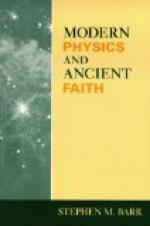The Oriental physics has been guarded most jealously. For many thousands of years it has been the real occult and esoteric teaching, while the Oriental metaphysics has been open and exoteric. It could not be understood without the key, and the key was in the physics known only to “the tried and approved disciple.” A little has leaked out—enough to whet the appetite of the true student and make him ask for more.
Chapter Two
The Two Kinds of Perception
To the savage, matter appears in two forms—solid and liquid. As he advances a step he learns it has three forms—solid, liquid and gas. He cannot see the gas, but he knows it is there.
A little further on he learns that matter as he knows it is only a minute portion of the great universe of matter—the few chords that can be struck on the five strings of his senses, and limited to one octave or key.
Whether the particular matter he investigates has a solid, a liquid, or a gaseous form depends upon its rate of vibration. If it is a liquid, by raising its rate of vibration one third it becomes a gas; by reducing it one third it becomes a solid.
Each kind of matter has vibration only through one octave. It is known to us only by its vibration in that octave. Each kind of matter has a different octave—is set on a higher or lower key, so to speak, but all octaves of vibration are between the highest of hydrogen gas and the lowest of carbon.
In mechanical compounds, such as air or brass, the rate of vibration of the compound is the least common multiple of the two or more rates. In chemical compounds, such as water or alcohol, the rate is that of the highest, the others uniting in harmonic fractions.
All matter as we know it through our senses—prakriti, as it is called in the Secret Doctrine to distinguish it from non-sensual matter—is the vibration of an universal Something, we do not know what, through these different octaves. The elementary substances (so-called) are one and the same thing—this Something—in different keys and chords of vibration; keys that run into one another, producing all sorts of beautiful harmonies.
Taking any one of these elements, or any of their compounds, all we know of it is limited strictly to its changes during vibration through one octave. What happens when the vibration goes above or below the octave has not yet been treated hypothetically.
While some elements are vibrating on higher and some on lower keys, we can consider them all as vibrating within one great octave, that octave of the universal Something which produces sensual matter, or prakriti.
But matter is not confined, we know, to this great octave, although our sensual knowledge of it is strictly confined to it. How do we know it?
Knowledge comes to us in two ways, and there are two kinds of knowledge.




